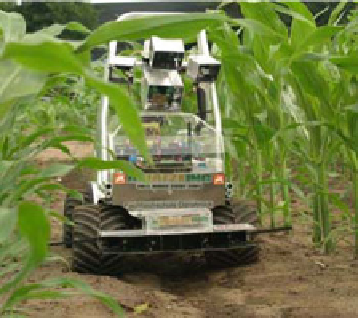Agriculture Reference
In-Depth Information
Fig. 11.6
Experimental
robot in maize (Photo:
Ruckelshausen)
identifi er for an infection. This can be detected with a spot sensor by successive
scanning or with images from cameras (Kuckenberg et al.
2009
; Moshou et al.
2005
). The image analysis of fl uorescence pictures is a very promising technique
and could be automated with increasing computational capacity.
For an effective sensing in a fi eld, the
sample size
is an important aspect:
Fungicides are applied typically in an area within the working width of a sprayer.
However, optical sensors for fl uorescence detect an area in the range of only some
mm
2
up to a few cm
2
when acting with artifi cial light. Small plots of infections
might start with a diameter of maybe some meters. Hence if the sensor is operating
in an on-the-go manner, there might be problems:
•
The measured area is only a very small spot sample of the whole fi eld (
e
.
g
. a line
of some mm of the 24 m working width).
•
The concerned leaf area (which is affected by fl uorescence changes due to infec-
tion) is too small and the sensed surface of some cm
2
shows up in an average
signal, which is not signifi cantly different from healthy plants.
•
The infected crop area is not measured, because the driving direction of the sen-
sor is not in line with the infected plot.
The solution could be smaller sensed sample areas that are obtained with
scan-
ning laser techniques
or a
series of small sensors
perpendicular to the driving
direction. A large size of the sensed area would be a good choice if the infection and
its fl uorescence signals extend over whole leaves or plants. Though this probably is
not the rule, it still might be necessary to have a signal which describes the average
plant property of an area where the application should be done. Depending on the
spraying technique, this could be within the range of the working width, within sec-
tions of the boom length or even only within the range of individually controlled
nozzles (Vondricka and Schulze Lammers
2009
).
The best way out of this dimensional problem between current spraying tech-
niques and the infected loci probably is to leave the detection and perhaps also the
treatment to small
scouting robots
(Fig.
11.6
). In the future, these small robots
might loiter through the fi elds and carefully inspect as well as treat individual plants.

